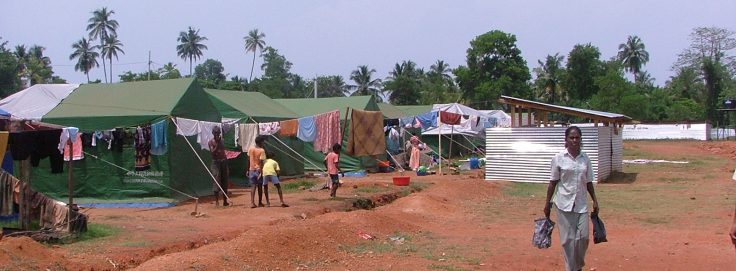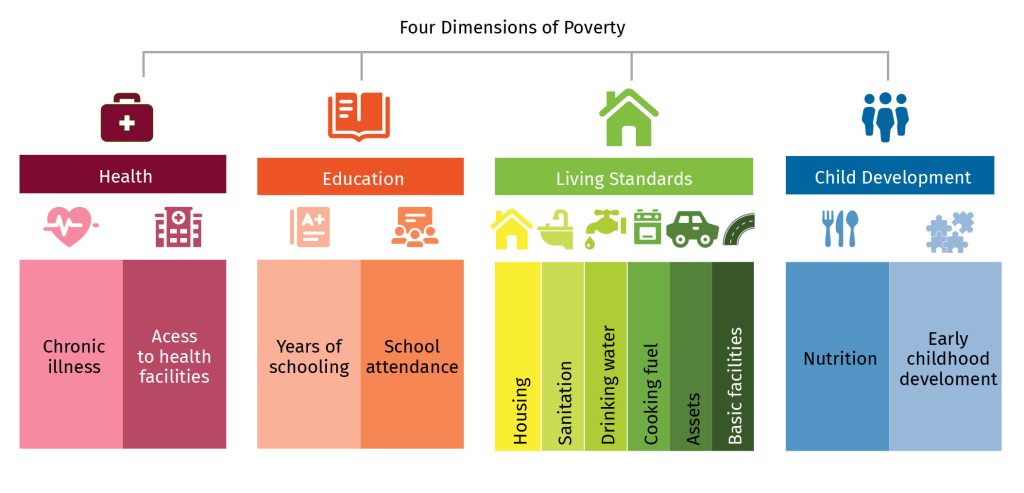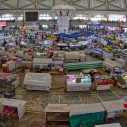
Search
Sri Lanka launches a child MPI directly linked to its national MPI

The Department of Census and Statistics (DCS) of Sri Lanka, with the support of UNICEF, has launched its national Multidimensional Poverty Index (national MPI) as an official statistical and policy tool, to inform high-impact policy design and sectoral coordination towards the acceleration of poverty reduction in the country.
The national MPI captures ten indicators grouped into three dimensions of poverty: Education, Health, and Standard of Living. Any person deprived in 33% or more of the weighted sum of indicators is considered multidimensionally poor.
The national MPI is compiled using data from the Household Income and Expenditure Survey (HIES), conducted in 2019 by DCS. With the support of UNICEF, the HIES has been expanded to add questions related to the national MPI, and to include a specific module to collect child-related information among children 0–5 years old, which is used in the linked child MPI.
According to the national MPI of Sri Lanka, 16% of the population are multidimensionally poor.
When the national MPI is disaggregated by age group, 14% of children under 5 years of age are multidimensionally poor. Sri Lanka’s national development plan, government policy strategies and international institutions recognize that reducing nutritional deprivations in children are a national priority, as is the care of cognitive development during the first years of their life.
Indeed, even short periods of deprivation, for instance on undernutrition and cognitive development, can permanently affect children’s long-term growth.
Therefore, a focus on early childhood poverty is key to inform child poverty policies that could have long-lasting effects in the development of the country’s human capital and its development path.
For these reasons, the DCS crafted and launched an individual child Multidimensional Poverty Index (child MPI) linked to its national MPI, specifically conceived for children 0-4 years old.
The child MPI is linked to the national MPI so that both measures together give consistent policy messages nationally, while the child MPI adds value by measuring the specific deprivations that poor children under the age of 5 experience.
A focus on early childhood poverty is key to inform child poverty policies that could have long-lasting effects in the development of the country’s human capital and its development path.
How are the national and child MPI linked? The child MPI includes the same indicators of the national MPI with the same relative weights. It adds a fourth dimension, Child Development, which has two key individual child indicators: nutrition and early childhood development. In the child MPI the poverty cut-off is one-quarter, so any child deprived in 25% or more of the weighted indicators is poor.
All the children who are poor by the national MPI are also poor by the child MPI, which is very important for policy consistency. In the case of the child MPI, the intensity of their poverty can be even higher if they are also deprived in any indicators in the Child Development dimension.
In addition, some children living in non-poor households according to the national MPI –households that are deprived in some of the ten indicators of the national MPI, but not enough to reach the poverty cutoff of 33% – are considered poor according to the child MPI because they are additionally deprived in either nutrition or cognitive development, or both.
This approach used to construct the child MPI, which makes it directly and precisely linked to the national MPI, is called the ‘drawer approach’, and Sri Lanka is pioneering in being the first country in the Southeast Asian region to use it to build an official measure of child multidimensional poverty.
Child Multidimensional Poverty Index of Sri Lanka

The child MPI of Sri Lanka identifies:
i) The percentage of children 0–4 years old who are multidimensionally poor (the incidence of child multidimensional poverty)
ii) The share of simultaneous deprivations poor children face (the intensity of child MPI),
iii) The level of multidimensional poverty of children 0–4 years old (the MPI value of the child MPI, which is equal to the product of the incidence and the intensity of child multidimensional poverty),
iv) Their composition of poverty by each indicator, and
v) Whether there are statistically significant differences among children of different ages or between girls and boys.
The results show that more than four out of every ten children under the age of 5 are multidimensionally poor, that is 42.2% of children 0–4 years of age.
The intensity of poverty indicates that each poor child experiences, on average, 35.1% of the weighted deprivations, which is equivalent to being deprived in almost one dimension and a half among the four dimensions of child poverty. The multiplication of these two numbers gives a value of 0.148 for the child MPI. If either the incidence or the intensity is reduced, overall child poverty – that is, the child MPI – will go down.
When analysing the composition of child poverty, results show that one-third (33.4%) of the children aged 0-4 years old are multidimensionally poor and themselves personally underweight or stunted; 16.4% are poor and deprived in early childhood development; 32.9% of the children are poor and lack access to a safe source of drinking water, and 17.3% are poor and live in a household where the access to health facilities takes 30 minutes or more.
Confronting these deprivations are top priorities for child poverty reduction in Sri Lanka. No significant differences are found between the poverty levels of girls and boys in Sri Lanka 0–4 years old, which reflects gender equity during the first years of life.
The incidence of both national multidimensional poverty and child multidimensional poverty in Sri Lanka, as well as their disaggregation by sex and age, are reported in the global database of Sustainable Development Goals (SDGs) as SDG indicator 1.2.2. that looks at the “proportion of men, women, and children of all ages living in poverty in all its dimensions according to national definitions”, enabling the tracking of national and child poverty reduction over time in the country.
By reporting their individual child MPI and their national MPI in the global SDG database, Sri Lanka joins other countries such as Nigeria that have built a linked child MPI measure to better understand the specific deprivations that children face over the course of their lives, which may be different to those experienced by adults.
A linked child MPI is a highly valuable tool for the different policy actors in Sri Lanka and worldwide who are committed to accelerating progress towards reducing poverty among children and in all its dimensions.
It facilitates the use of information for effective policy action by providing key messages that reduce competition between advocacy groups by guiding them towards the same direction and by offering additional child-specific insights to improve the identification of the most vulnerable individuals.
This contributes to building a framework of evidence-based policymaking for better planning and improved collective action to advance Sri Lanka’s goal of ‘leaving no one behind’.
This article was published in Dimensions 15
















